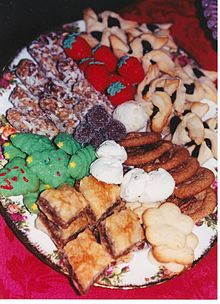| This article needs additional citations for verification. Please help improve this article by adding citations to reliable sources. Unsourced material may be challenged and removed. Find sources: "Spritzgebäck" – news · newspapers · books · scholar · JSTOR (March 2013) (Learn how and when to remove this message) |
 | |
| Type | Biscuit / Cookie |
|---|---|
| Place of origin | Germany, France (Alsace and Moselle) |
| Main ingredients | flour, butter, sugar, eggs |

Spritzgebäck (German: [ˈʃpʁɪt͡sɡəˌbɛk] ), also called a spritz cookie in the United States, is a type biscuit or cookie of German and Alsatian-Mosellan origin made of a rich shortcrust pastry. When made correctly, the cookies are crisp, fragile, somewhat dry, and buttery.
The German root verb spritzen (German: [ˌʃpʁɪt͡sn̩] ) is cognate with the English to spurt. As the name implies, these cookies are made by squeezing, or "spritzing", the dough through a cookie press fitted with patterned holes (or extruded through a cake decorator or pastry forcing bag to which a variety of nozzles may be fitted).
See also
References
- Dede Wilson (11 October 2011). Baker's Field Guide to Christmas Cookies. Houghton Mifflin Harcourt. p. 146. ISBN 978-1-55832-628-6. Retrieved 19 April 2012.
This German dessert–related article is a stub. You can help Misplaced Pages by expanding it. |